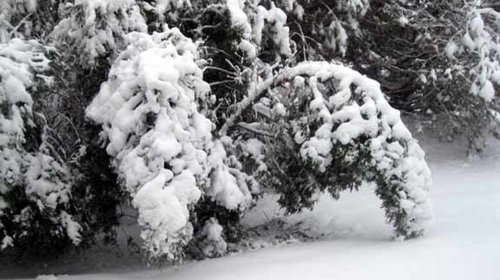As the holiday season comes to a close, we start to enter the long, dreary, cold days of winter. It's Connecticut, and it doesn't really get that cold here in Connecticut until January. Now is when you see the temps start to dip into the 20's, days of 50° will soon be a distant memory.
Winter is as tough on trees as it is on us. Trees may look dormant as they go into winter but in fact, they continue to regulate your metabolism and only slow down there physiological activities. Even though they appear to be inactive, they are still growing roots they still respire, and they still take in water and nutrients during the dormant season. Sometimes trees are more susceptible to injury and damage in the winter, then they are during the spring and summer months.This is particularly true of evergreens.
A younger tree, even if dormant, still needs to be winterized to remain healthy come spring!
So, how do you winterize a tree?
1. Pruning. Always prune dead, diseased, or overlapping branches in the late fall. This will not only enhance the overall shape of the tree and encourage strong growth in the spring, but it will also minimize winter storm damage. Trim away branches that can touch the ground and become overloaded with snow or rain. When heavily weighted, it can come into contact with the soil, which can invite undesirable pests. These branches can also break with heavy snow loads, and can leave a wound in the tree. Crossing branches can bump up against one another can also lead an injury in the tree and invite disease and insects. Crossing branches should be pruned for the health of the tree, but it's also a good aesthetic practice as well.
2. Mulch. Mulch dormant trees? Why would I want to mulch a dormant tree? Mulcht is more than just a pretty face. Mulch actually serves several purposes, one of which is to insulate routes from the crazy fluctuating temperatures we have here in Connecticut. We all know how it can be 50° one day and 20° the next. That is hard on young trees as it is on us . A good layer of mulch can insulate tree roots from fluctuating temperatures. Mulch also helps retain moisture. We don't think about this in the winter time, but it could be particularly difficult for trees to absorb moisture when the ground is frozen. Mulch is a good insurance policy that your tree roots will be well insulated and have a sufficient amount of moisture to take the tree through the winter.
3. Put your tree on a diet. What??
Remove just a minimal amount of foliage mass from the upper part of the tree, called the crown, so that there is less branch resistance to wind. This is an especially great practice considering some of the larger wind storms that we had. During windy winter periods, the foliage and branches your tree will be less susceptible to breakage. By thinning the crown of the tree this allows the wind to move more freely thus reducing the wind load upon the limbs. Pruning the crown of your tree will produce a better structure without grossly changing the overall size or shape of the tree.
4. Prevent injury. Remove any dead, or leaning trees. These trees have a weak structural integrity and can possibly fall on and damage, or kill, your young tree. Be sure your trees, especially conifers, get enough water in the fall. The most obvious winter injury in trees is in conifers who start to have the appearance of reddish brown foliage. This is usually due to freezing following a spell of warmer weather. Your tree will start to respire, and may not have enough water to replace the water that has a evaporated through it's respiration process. Either a burlap wrap, or a product such as Wilt Proof can help prevent winter desiccation, or water loss. Winter injury on hardwood trees is a little bit more difficult to diagnose. Winter injuries on hardwood trees can include branch and bud damage, early leafing out, or no leafing out at all. Sometimes the way our winter cycles, we can have some warm days, and then we find ourselves plunged back into the frigid and sub-arctic temperatures that Connecticut winters can dish out. If your young tree breaks dormancy too early, and starts to push out shoots, a late frost such as we had last year can cause shoot death.
Most of the potential winter injury that can occur on young trees can simply be avoided if you use trees that are hearty to your zone. Keep in mind the Connecticut zones are changing and what might be hardy on the shoreline may not be hardy inland or up near the Massachusetts border. Proper watering, fertilizing, and a generous layer of mulch will help protect roots and prevent cold injuries. Trees are more susceptible to cold injury during winters that are especially cold, without snow cover. It seems to me that more often than not Connecticut does in fact lack a long period of snow cover, so be sure to protect your young trees with the suggestions we mentioned here and you will have years of enjoyment from your tree.














gardengal48 (PNW Z8/9)
M&M Garden Designs, LLCOriginal Author
Related Discussions
Idyll 301 Baby It's Cold Outside!
Q
Baby it's cold outside... but I'm getting the fever!!!
Q
Oh baby, it's cold outside!
Q
Baby It's Cold Outside
Q